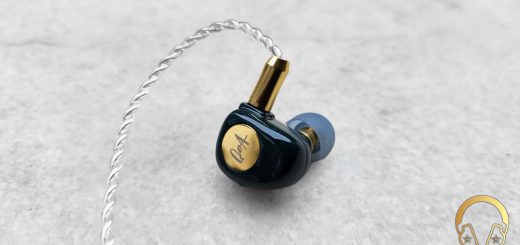FLC Technology FLC 8D Review
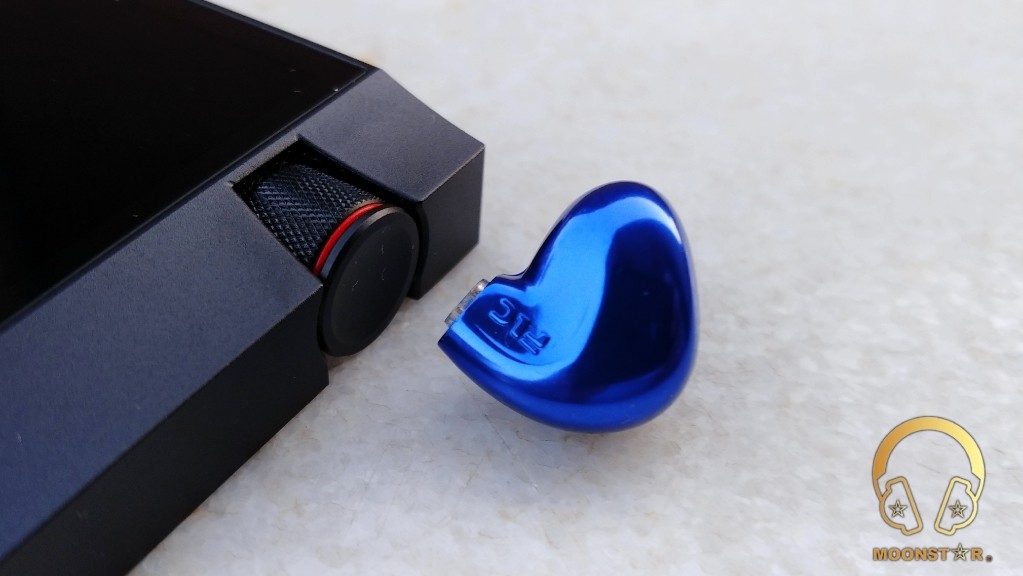
FLC Technology FLCD Review
The True Friend of all Music Genres!
About FLC Technology:
FLC Technology Co. Ltd. is based in China and is committed to developing and producing high-end in-ear monitors (IEM) and custom in-ear monitors (CIEM). In 2011, FLC were one of the first companies in China to launch a hybrid CIEM.
The FLC 8 was there first hybrid IEM, featuring the ability to customize 36 different sound signatures to your liking; the FLC Technology FLC 8 came many nozzle filters and plugs.
Now I want review the FLC 8D, which is one of their latest product together with the FLC 8N and FLC Celeste.

Disclaimer:
The FLC 8D IEM was provided to me by FLC Technology via Lend Me UR Ears as a review sample. I am not affiliated with FLC Technology or Lend Me UR Ears and any third person beyond this review and all these words reflect my true, unaltered, opinions about the product.
The Price:
The FLC 8D can be found under the following purchase link;
Purchase link: http://www.lendmeurears.com/flc8n/
Package and Accessories:
The FLC 8D came in a light brown cardboard box, which sports silver printed FLC Logo. This box has a magnetized cover and a folding system, which is separated in to partitions. At the first partitions you can find the FLC 8D monitors buried in to a yellow foam mold. At the second partitions you can find the following accessories;


- 1 pair x FLC 8D In-Ear Monitor
- 1 pcs x 2.5mm Balanced or 3.5mm Single Ended 2 Pin Cable (depends on your order)
- 8 pairs x Silicone Eartips (Each two pairs of L/M/S/Ultra-S size)
- 4 pairs x Sound Tuning Filters (Gold, Gunmetal, Green and Blue filters)
- 1 pcs x Tuning accessories box
- 1 pcs x Tweezer
- 1 pcs x Earwax cleaning tool
- 1 pcs x 1/4″ to 3.5mm Adapter
- 1 pcs x Airplane earphone adapter
- 1 pcs x Shirt Clips
- 1 pcs x Metal Hard Case
The metal case that is included to the box looks pretty stylish and has a velvet inner coating, which should protect the FLC 8D from possible impacts and scratches.


There is also a metal capsule in blue color with a screw system and a key ring, where you can find 4 pairs of sound tuning filters that are the Gold, Gunmetal, Green and the Blue one. Those sound tuning filters are screwable. Those filters are the highlight of this In-Ear Monitor.


The box is also including a Shirt Clips, Tweezer, 1/4″ to 3.5mm Adapter and Earwax cleaning tool, which are a nice additional.

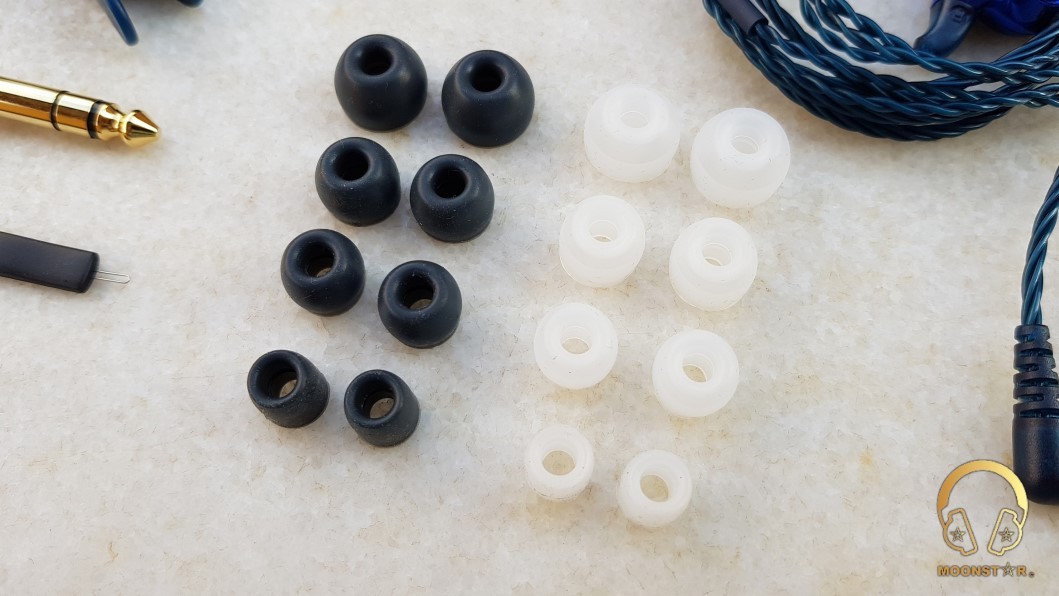
Design, Fit and Build Quality:
The housing of the FLC 8D is made of CNC machined metal which looks and feels very durable in my hands. The shell has a dark blue housing with a metallic/reflective appearance, which looks pretty nice.

On front the monitor shell is a small FLC Logo.

On the rear are the sound nozzle where you can screw in 4 different types of sound filters for midrange & treble tuning and 3 mini holes which are serving for bass ventilation.


On the Top is the 0,78mm female plug, where you can attach your upgrade cable with 2pin male connectors.

When it comes to aspects like fit and comfort, I can confirm that the FLC 8D is giving a pretty comfortable wearing experience and can be worn for many hours without to hurt your ears. The only negative in terms of comfort is the cable which is a bit uncomfortable to wear over the ear.

The isolation of the FLC 8D is on an average level that is enough to use it in environments such like bus, metro or train.
The Cable:
According to FLC Technology Specs; the FLC 8D comes with a 4 core braided 7N crystal copper wire with a purity of 99.99998%. This cable was produced by a self-designed special weaving machine, which is providing no welding in the cable, to ensure that the signal is lossless during the transmission process.
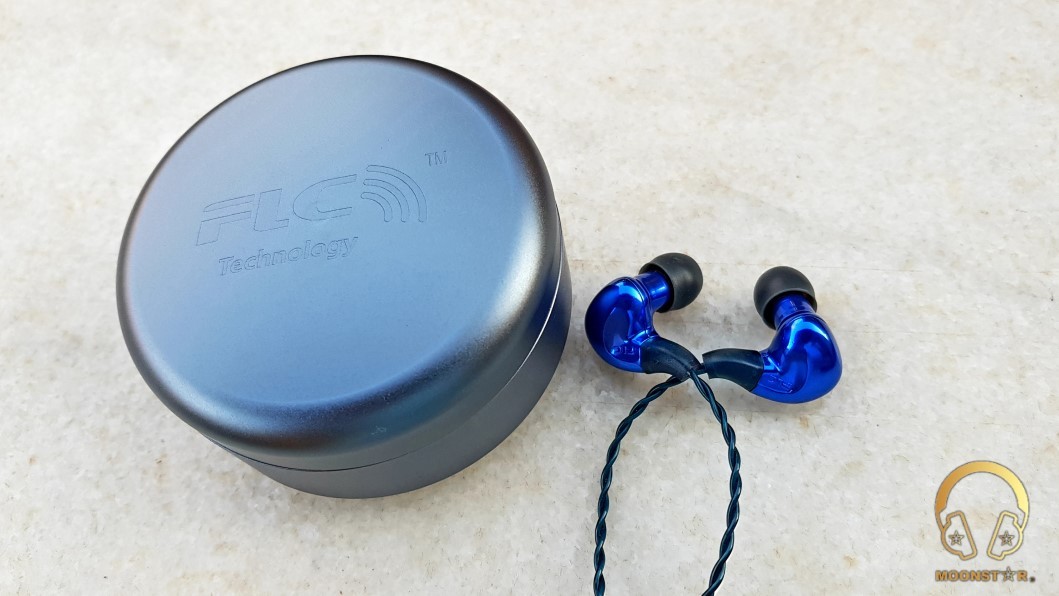
The Cable has a nice blue colored plastic coating with relative low microphonic effects.

This cable has 0.78mm male connectors and a right angled 2.5mm Balanced or 3.5mm Single Ended Headphone Jack depending of your purchase.
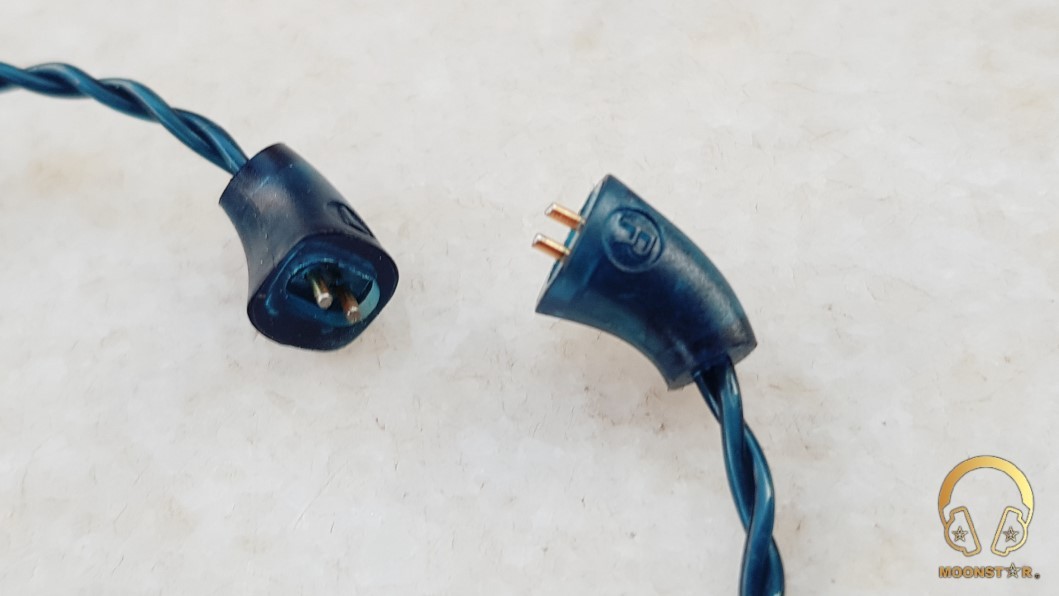
The cable sports a chin slider and a y splitter that are made of plastic.

Technical Specifications:
- Driver : Hybrid Driver 1 x 8.6mm Dynamic Driver + 2 x Balanced Armature
- Sensitivity : 107dB / mW, 1000Hz
- Frequency Response : 20-20KHz
- Impedance : 11 Ohm
- Connector : 0.78mm
- Cable Length : 1.2 Meters
- Plug : 2.5mm Balanced or 3.5mm Single Ended Plug with Gold Plating
Drivability/Sensitivity:
The FLC Technology FLC 8D is a pretty efficient IEM with fairly low impedance of 11 ohm’s which makes it to an ideal In-Ear Monitor for the use with portable sources such like smartphones, tablet’s, etc.. It can be driven easily to high volumes without to need an external amplifier.

Sources:
a) In Ear Monitor : FLC Technology FLC 8D, FiiO FH5
b) DAP/DAC : QLS QA361, Cayin N5II, FiiO M7, Astell&Kern A6norma SR15, Astell &Kern AK70, HiFiMAN Supermini

Albums & Tracks used for this review:
- B.B.King – The Trill is Gone (Tidal Hi-Fi)
- Dave Gahan – Kingdom (Tidal Hi-Fi)
- Leonard Cohen – You Wnt it Darker (Spotify)
- Eric Clapton – Wonderful Tonight True (Flac 24bit/96kHz)
- Metallica – Sad but True (Flac 24bit/96kHz)
- Megadeth – Sweating Bullets (Tidal Hi-Fi)
- Opeth – Damnation (Tidal Hi-Fi)
- Liquid Tension Experiment 2 – Acid Rain (Spotify)
- London Grammar – Interlud (Live) (Flac 24bit/44kHz)
- Laura Pergolizzi – Lost On You “Live at Harvard and Stone” (Tidal Hi-Fi)
- First Aid Kit – My Silver Lining (Spotify)
- Minor Empire – BulbulumAltinKafeste (Spotify)
- Vivaldi – Le QuarttroStagioni “The Four Season” (Tidal Hi-Fi)
- Alboran Trio’s – Cinque Lunghissimi Minuti (Tidal Hi-Fi)
- Otto Liebert & Luna Negra – Up Close “Album” (DSF) – Binaural Recording
- Lorde – Team (Flac 24bit/48kHz)
- Massive Attack – Angel (Tidal Hi-Fi)
- Portishead – It Could Be Sweet (Spotify)

The Sound:
The FLC 8D is a very musical and genre friendly In-Ear Monitor with a slightly warmish tonality. The bass is fast and gives a nice weight to the overall presentation. The midrange shows a hint of warmness and is slightly laid back in its presentation, while the treble, especially the upper treble range are vivid and airy in its presentation.
As I have mentioned before, the FLC 8D have 4 pairs of sound tuning filter with which you are able to change the sound character especially the midrange and the treble.
The Sound Tuning Filters:
- Gold Filter : Most mid-frequency and medium high frequency
- Blue Filter : Less mid-frequency and less high frequency
- Green Filter : Medium mid-frequency and most high frequency
- Gunmetal Filter : Medium mid-frequency and medium high frequency
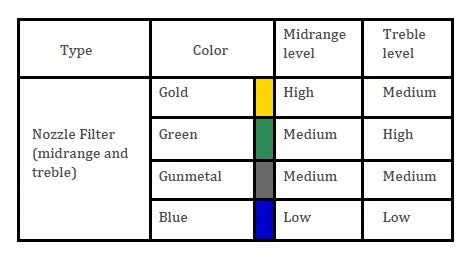
The Bass:
The FLC 8D has no bass tuning plugs like the FLC 8S and the FLC 8N that means that the bass character remains pretty identical, even if you change the filter that is showing only small changes in the midbass area.
The general bass character of the FLC 8D can be described as powerful but clean with focus to the subbass region. The speed in this range is above average and is showing good control and doesn’t overshadowing the rest of the sound spectrum. The subbass of the FLC 8D goes pretty deep and is showing good extension.
The bass of the FLC 8D is pretty detailed and is showing a pretty good refinement which is rarely found in this price category. The bass is tight and the quantity will satisfy most listeners with exception of those that describe itself as a bass-head.
The midbass of the FLC 8D has less weight in the lower frequency region than the subbass (20 – 50 Hz) and the bass (60-250 Hz), but is showing an pretty clear character and gives the overall sound a full bodied presentation.
Instruments such as bass guitars, contrabass, etc are shown by the FLC 8D with a fairly natural presentation.
The bass presentation of the FLC 8D is also pretty clean and smooth without to overwhelm you even after long listening periods.

The Midrange:
The FLC 8D has a slightly laid back midrange presentation with a slightly warmer than neutral (warmish) tonality. As I mentioned before, there are 4 (four) sound tuning filter that are able to change the midrange and treble presentation.
a) Midrange – Gold Filter:
The Gold filter is my personal favorite because of the additional emotion of the vocals compared to the other 3 filters. This filter is the ideal choice for those who prefer an intimate vocal presentation.
The Gold filter are showing a transparent, full bodied and detailed midrange performance, where vocals are positioned slightly behind of the instruments. The gold filter performs also pretty well in terms of vocal and instrument separation, without to show any remarkable mixings and unwanted sibilance issues. Both male and female vocals are fairly detail, while male vocals have good depth and female voices showing a soft and full bodied presentation.
The Gold filter is superior to all other filter (Gunmetal, Green, and Blue) in terms of detail, airiness and for vocal/instrument performance.
b) Midrange – Gunmetal Filter:
The Gunmetal filter has a more fairly balanced midrange presentation where the mids are slightly more recessed than with the Gold filter. When it comes to the vocals, both male and female voices are sharing a pretty equal sound performance.
The gold filter sounds warmer and more intimate than the Gunmetal filter, which can be described as fairly more balanced in its sound characteristic.
The detail level of the Gunmetal filter is slightly inferior in performance, compare to the Gold filter, but is superior to the Green and Blue filters.
c) Midrange – Green Filter:
The Green filter shows the brightest midrange tonality of this filter collection due to the stronger upper midrange and treble emphasis. This sound character makes the overall presentation of the midrange noticeable airier and spacious than the Gold and Gunmetal filter, but more prone to sibilance and harshness.
Both male and female vocals sounding thinner and brighten than with those of the Gold and Gunmetal filter.
The Green filter sounds less natural and emotional compared to the Gold and Gun metal filter, but is superior in terms of airiness and clearness.
d) Midrange – Blue Filter:
The Blue filter has the most recessed/laid back midrange presentation of all sound tuning filters. The midrange is not as airy and bright like the green filter and it’s missing some detail and clearness you can find with the other three filters. The overall midrange presentation is slightly veiled and is missing the lush timber you can find with the Gold filter.
The Blue filter is the most forgiving and relaxed sounding filter in the collection that is ideal for those who are sensitive to brightness and are looking for a fatigue free listening experience. This filter is also the perfect choice for bad mastered tracks such like Metallica’s – Sad but True.
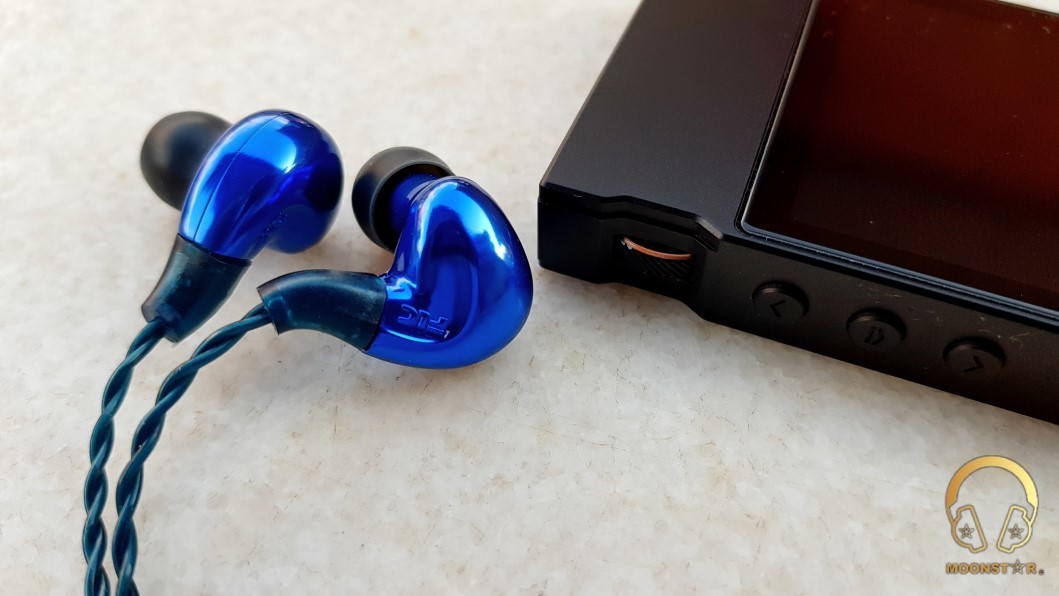
The Treble:
The FLC 8D has a noticeable roll-off in the lower treble range, while the upper treble (brilliance) is boosted with a peak around 7kHz. The general treble presentation is bright, airy with a nice amount of sparkle and pretty good extension.
The Filters, which are coming with the FLC8D, are showing a quite noticeable difference in performance and character. The Green one is the filter with the highest treble quantity, while the blue one has the lowest treble response. The Gold and Gunmetal filters on the other hand are pretty balanced in terms of treble response.
The Gold and Gunmetal filters have a fairly balanced treble presentation compared to the Green and Blue filters. Both of these filters are showing the right amount of sparkle and air, which is needed for an IEM to be classified as Hi-Fi. The best thing about the Gold and Gunmetal filters is the very low sibilance and harshness, while I have listen to Megadeth’s – Sweating Bullets or Metallica’s – Sad But True.
The Gunmetal filter sounds slightly more detailed and emphasized than the Gold filter, while the treble quantity and extension of the Gunmetal are superior to the Blue, but inferior to the Green filters.
The Blue filter on the other hand, has the lowest treble quantity of all four filters. The Blue filter has a lower treble quantity and less extension compared to all other filters, but is ideal for those who have treble sensitivity and are looking for a treble tuning, which is ideal for long listening periods.
The green filter has the airiest, most spacious and detailed sounding treble presentation, which makes it to a ideal choice for genres such like classical music, while it doesn’t suite for modern genres such like pop or rock due the relative bright nature and thin presentation, which is a bit prone to harshness. The Green filter has the best treble extension, while treble tonality is slightly unnatural, metallic and cold compared to the Gold and Gunmetal filter.

Soundstage:
The soundstage of the FLC 8D is showing an above average performance in terms of wideness and depth of the stage, which is ideal for a quite precise placement and separation of instruments, even in complex passages. The soundstage is wider than its depth and is showing a pretty spacious and airy presentation.
FLC 8D versus FiiO FH5
Both the FiiO FH5 and the FLC 8D are In-Ear Monitors with Hybrid Driver (BA + DD) configuration.
The FiiO FH5 has a W-shaped sound signature in which the subbass, the female vocals and the upper middle range are pronounced and the male vocals and the midbass are slightly recessed in its presentation. The FLC 8D, on the other hand, has a sound tuning option (filter), allowing us to change the sound from neutral, to warmer, and more full-bodied presentations.
The FiiO FH5 features a subbass with good depth and a moderate-intensity bass, while the FLC 8D can produce a higher subbass depth and a slightly stronger bass.
The midbass presentation of the FLC 8D is quite powerful and punchy, while it is superior to the FiiO FH5 in terms of speed and control.
We can play with the midrange of the FLC 8D with its sound tuning filters. The FiiO FH5, on the other hand, has a midrange that is slightly set back, with the exception of the female vocals, which are more in the foreground due to the higher center emphasis.
The midrange of the FiiO FH5 is warmer than that of the FLC 8D, which has slightly less warmth and additional transparency. The male vocals of the FLC 8D are deeper and more detailed than the FiiO FH5. The FH5 is more successful with female vocals when you use the FLC 8D with the blue and green filters, but is superior to the FH5 when the Golden Filter comes is n use.
Both IEMs have a fairly controlled and fatigue-free appearance of the upper midrange with good transition. In this frequency range, the FLC 8D has the upper hand with its slightly higher transparency, airiness and resolution.
The treble presentation of the FLC 8D and the FiiO FH5 is energetic, lifelike and has a good extension. The lower treble range of the FiiO FH5 is more pronounced, while the upper treble (presence) of the FLC 8D is more pronounced and also more detailed than those of the FH5. The FLC 8D is superior to the FH5 in terms of treble expansion, while the FiiO FH5 is more successful in terms of control.
The soundstage of both In-Ear Monitors is suitable for a very accurate separation and placement of instruments. The main difference is, that the FLC 8D has the wider stage, while the FiiO FH5 has a bit more depth. I can also confirm that the soundstages of both IEMs are pretty airy and spacious in their presentation.

Conclusion:
The FLC 8D is a very capable In-Ear Monitor that shares a good level of detail and that a solid build quality. It will be a true nightmare for other In-Ear makers who are selling the same sound for double the price. The genre friendly sound characteristic of the FLC 8D and the capability to chance the sound signature based on your preference makes this IEM to a bang for the buck.
Pros and Cons:
- + Genre friendly sound tuning
- + Very emotional and nicely detailed midrange (Gold Filter)
- + Clarity
- + Deep subbass and full-bodied presentation
- + Sound Tuning Filters
- + Nice accessories package
- – The over the ear design of the cable is a bit uncomfortable
- – Soundstage could be slightly deeper



